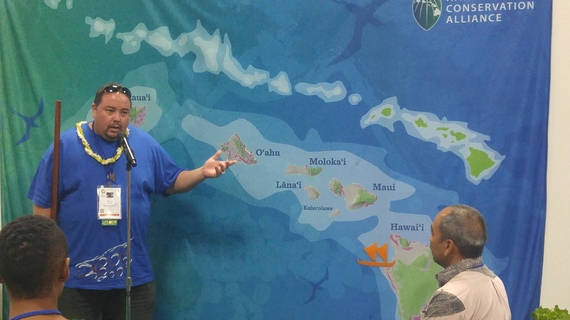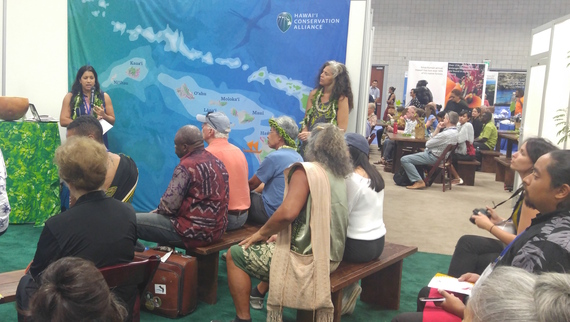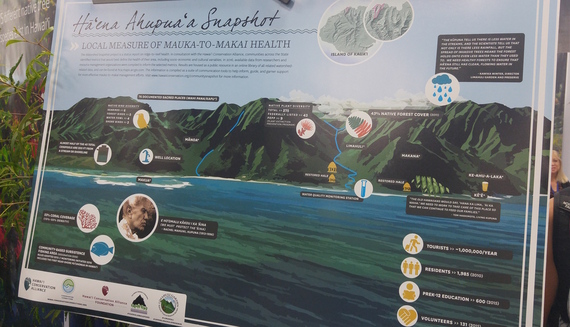Small communities across the Hawaiian islands are finding big treasures in the recovery of past practices.
Speaking at one of the panel discussions during the IUCN World Conservation Congress in Honolulu last week, Kevin Chang, Executive Director of KUA Hawaii, recalled the proverbial story of the man who scoured the world looking for diamonds. "He eventually came home and found diamonds by digging right in his backyard," said Chang.

Kevin Chang, ED, KUA Hawaii: Weaving equitable relationships between the community and government agencies is important to managing natural resources.
"At KUA we try to make sure people don't waste time looking elsewhere for the solutions that are right in front of them. We have seen the networks we serve identify the stresses on their communities themselves. They know the places where they live intimately, better than any expert from the outside does. We have seen them discover solutions to their problems by digging into the past. Our job at KUA has been to support those efforts and weave equitable, mutually helpful relationships with the government agencies that today are charged with overseeing natural resources that communities used to manage themselves. That's how we are helping people discover diamonds in their backyard," he said.
Training the next generation
Fourteen year old Grace Gonzaga of Hakipuʻu Learning Center recounted the excitement of being part of an after-school NOAA-funded Hui o Hauʻula Watershed Detective Program.
"At first it was just a cool thing to do after school. But I quickly saw that it was much more than a fun activity. I now know how important it is that we learn as much as we can so that we can be better at protecting the fresh water and the places where we live and fish and grow our food," she said.

Looking on as Grace Gonzaga speaks, are (from the left), Ken Furukawa and Dotty Kelly-Paddock from the Hui o Hau'ula, and on the right is Raynae Tessie Fonoimoana.
A member of the audience challenged the group to go further. She referenced lessons in watershed management from places she had visited and studied, like Peru. She asked the group what kind of measurements they use to monitor aquifers and to better understand what happens to groundwater.
Dr. Kawika Winter, Director of the Limahuli Garden and Preserve, National Tropical Botanical Garden on Kaua`i welcomed the question, comparing the effort to trace the connections within the watershed to how a symphony orchestra makes music. "We are working hard to understand and follow that music, and see how it all comes together," he said.
"When the state agencies moved from the ahupuaʻa system and created new arbitrary divisions, they disrupted a carefully tended native system of protocols for managing our land and water. We are now dealing with some of the consequences of that disruption, with seepage from septic systems fouling our springs, for instance. That has consequences for fishing and food security," he said.
Pointing to charts showing local measures of the health of the Hāʻena ahupuaʻa, Winter observed that the numbers cause discomfort in some quarters.
"People balk at that one million tourists per year figure in an area that has fewer than 2000 residents. But those are the facts. And yes, that has an impact," he said. "And we have to ask ourselves how we deal with it before it is too late."
The idea of a complex system coming together in an ecology of abundance was echoed by Chris Cramer, Executive Director of the Maunalua Fishpond Heritage Center. He described a time when the fish were so plentiful, people used to be able to scoop them up when the schools came in, swimming against the current, drawn by the smell of fresh water from the springs. "It was a beautiful system--the heiau on top, the spring below, feeding into the loko iʻa. We are working on restoring the Kalauha'eha'e fishpond and reversing some of the damage caused by development as defined by Henry Kaiser," he added.

Outgoing Hawai'i Conservation Alliance's Executive Director, Lihla Noori invited the audience to share lessons learned managing the watershed in their ahupua'a.
Running through the remarks made by the speakers and comments from the audience was a strong sense of urgency about the need for the different players in the state to work closely with the community to share lessons learned about how best to restore and maintain the health of the ahupua'a. The session was organized and hosted by the Hawai'i Conservation Alliance, a collaboration of the State of Hawaiʻi's largest conservation landowners and organizations from government, cultural, educational, and non-profit organizations dedicated to safeguarding the biodiversity of Hawaiʻi's ocean, land, and streams.
Outgoing Executive Director Lihla Noori used the occasion to introduce her successor, Emma Anders, both of whom have devoted several years to working with the community and with government agencies, tackling conservation and land use challenges.
"We draw our inspiration and energy from the Hawaiian understanding that our relationship to the land is as to an elder sibling that deserves our care and respect.," said Noori.

